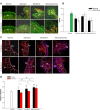Nonlinear optical microscopy signal processing strategies in cancer
- PMID: 24737930
- PMCID: PMC3981479
- DOI: 10.4137/CIN.S12419
Nonlinear optical microscopy signal processing strategies in cancer
Abstract
This work reviews the most relevant present-day processing methods used to improve the accuracy of multimodal nonlinear images in the detection of epithelial cancer and the supporting stroma. Special emphasis has been placed on methods of non linear optical (NLO) microscopy image processing such as: second harmonic to autofluorescence ageing index of dermis (SAAID), tumor-associated collagen signatures (TACS), fast Fourier transform (FFT) analysis, and gray level co-occurrence matrix (GLCM)-based methods. These strategies are presented as a set of potential valuable diagnostic tools for early cancer detection. It may be proposed that the combination of NLO microscopy and informatics based image analysis approaches described in this review (all carried out on free software) may represent a powerful tool to investigate collagen organization and remodeling of extracellular matrix in carcinogenesis processes.
Keywords: anisotropy; gray level co-occurrence matrix; nonlinear microscopy; nonlinear signal; tumor-associated collagen signatures.
Figures



References
Publication types
LinkOut - more resources
Full Text Sources
Other Literature Sources

